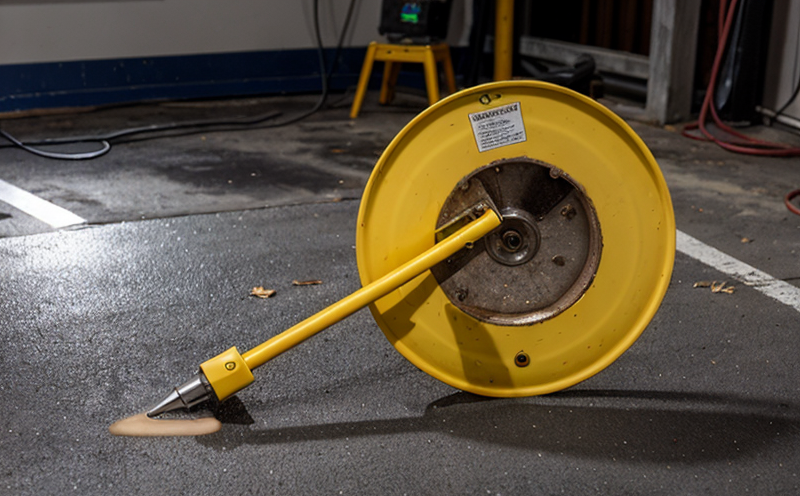ISO 4993 Radiographic Testing of Steel Forgings
The ISO 4993 standard is a cornerstone in the non-destructive evaluation (NDE) of metallic components, particularly for steel forgings. This method allows quality managers and compliance officers to ensure that critical parts meet stringent material integrity standards without compromising their functionality or performance.
During ISO 4993 radiographic testing, high-energy X-rays are directed at the forging, illuminating any internal defects such as cracks, porosity, slag inclusions, and other imperfections. The resulting image is captured on film or digital media, which can then be analyzed by trained personnel to determine the forgings’ fitness for purpose.
The process begins with thorough preparation of the forging according to ISO 4993 guidelines. This includes ensuring that the part is clean and free from surface contaminants that could obscure internal flaws. The specimen is positioned in a controlled environment, often using specialized fixtures designed to hold it securely during exposure.
Once properly aligned, the radiographic testing process involves exposing the forging to high-energy X-rays from a reliable industrial source such as an X-ray tube or electron beam generator. The radiation penetrates through different densities within the metal, creating variations in contrast on the film or digital sensor. These differences are interpreted by technicians trained in radiography to identify potential flaws.
ISO 4993 specifies detailed criteria for interpreting these images, including the use of reference standards and penetrameters to establish acceptable limits for various defect sizes. Compliance with this standard ensures that only forgings meeting strict quality requirements are approved for use in critical applications like aerospace, automotive manufacturing, and heavy machinery.
The results of ISO 4993 radiographic testing are documented rigorously according to international standards. Reports typically include detailed descriptions of any defects detected along with their location within the forging. This information is invaluable for quality assurance teams responsible for ensuring product reliability across industries.
In summary, ISO 4993 radiographic testing provides a robust means of assessing steel forgings' integrity without damaging them—a vital capability given the precision demanded by modern manufacturing processes. By adhering to this standard, manufacturers can enhance safety while maintaining operational efficiency in producing high-quality components.
| Industry Sector | Application Example |
|---|---|
| Aerospace Manufacturing | Ensuring structural integrity of engine components. |
| Automotive Manufacturing | Verifying wheel hub assemblies for durability. |
| Military Equipment Production | Evaluating armor plating and structural supports. |
| Medical Device Fabrication | Checking prosthetic joints for internal defects. |
| Heavy Machinery Construction | Assessing crane and excavator parts for safety. |
International Acceptance and Recognition
The ISO 4993 standard has gained widespread acceptance across numerous industries due to its rigorous approach to ensuring the quality of steel forgings. Many countries have adopted it as part of their national standards, recognizing its value in promoting consistent practices worldwide.
Organizations like ASME (American Society of Mechanical Engineers) and ASTM International incorporate ISO 4993 into their own guidelines for radiographic examination of materials. This cross-industry support underscores the importance of this method in maintaining high standards globally.
Compliance with ISO 4993 not only enhances product quality but also facilitates international trade by ensuring that components meet universally accepted criteria. For companies operating internationally, adhering to such widely recognized standards can streamline regulatory approval processes and reduce barriers between different markets.
In conclusion, the global acceptance of ISO 4993 reflects its significance in upholding safety and reliability across various sectors relying on steel forgings. By leveraging this standardized testing procedure, businesses contribute positively towards advancing industrial excellence while complying with international best practices.
Use Cases and Application Examples
The application of ISO 4993 radiographic testing extends beyond mere compliance; it plays a crucial role in safeguarding critical infrastructure and enhancing product performance. In aerospace manufacturing, for instance, ensuring the structural integrity of engine components is paramount to preventing catastrophic failures during flight.
Automotive manufacturers rely on this method when verifying wheel hub assemblies for durability, knowing that even small flaws can lead to severe accidents if left unchecked. Military equipment producers use it extensively in evaluating armor plating and structural supports, where any compromise could result in fatal consequences on the battlefield.
In medical device fabrication, radiographic testing ensures that prosthetic joints are free from internal defects, which is essential for patient safety. For heavy machinery construction firms, assessing crane and excavator parts helps maintain operational efficiency while reducing maintenance costs associated with premature failures.
These use cases highlight how ISO 4993 contributes significantly to various industries by providing a reliable means of detecting hidden flaws early in the production cycle. Through meticulous adherence to this standard, manufacturers can build trust among customers and stakeholders, ultimately fostering long-term success.





